Photography is many things. It is technical, it is light, it is composition, it is a lot of theory, a lot of doubts, a lot of inquiries from books, websites and forums, but above all photography is a lot, a lot of practice with a touch of inspiration, all mixed results in a highly trained photographer?
If we talk about gastronomic theory you have this complete guide to help you work, but if we talk about inspiration I hope that this article will encourage you to put into practice all this theory, all these tips and ideas that go through your head.
- It is a widely used format in culinary photography.
- As it allows you to better focus your attention on the main theme.
In culinary photography nothing is left to chance and everything must be artistically justified, take care of the details rigorously and you will get excellent results.
All this photograph that you can prepare, think and design, requires more from you and your creative part than that that that happens spontaneously before your eyes (documentary photography, for example). That’s why being creative, trying new compositions, materials, textures, becomes one more ingredient of culinary photography.
The zenith format (seen entirely from above, such as this image), 45-degree angles or the “normal” point of view are among the most commonly used in culinary photography.
Although this is not always the case, culinary photography will often be based on finished dishes, it is very important that, above all, the dish has an appetizing appearance and in good condition, so speed is an indispensable condition to photograph such scenes, since many foods perish quickly (speaking photographically) and lose their initial freshness in a few minutes.
It’s true that we eat in sight, isn’t it? The view is a sense that allows us to evaluate whether a food is in good condition or not, it allows us to guess the taste or texture that it will have in our mouth, so it is so important to take care of the aspect of what we are going to photograph. In culinary photography, texture is therefore one of the most important elements to consider. This is usually done with a side lighting system.
Depth of field is the focused area of our image. It is achieved by opening the diaphragm; the greater the aperture, the lower the depth of field and vice versa, the smaller the aperture, the greater it will be. Depth of field helps us focus our attention on a specific point in the image and is widely used in culinary photography.
To prevent the image from acquiring unwanted tones that could turn the image into something unreal or un gm, it is best to work with a manual white balance or check at any time that your camera interprets it. properly sings the light in front of you.
The woods are very photogenic because they give us a texture and a natural air that goes very far with the photography of natural products. Always try to have their color help you highlight the elements that appear in the image as in the sample photo.
Another way to present a dish is through its ingredients, not only the final result is what counts, but the entire process.
The final presentation of the dish is the final image of the series, not only must be appetizing, but also visually beautiful.
Negative space and the rule of thirds can be very useful in this type of photography.
Culinary photography, due to the relatively low logistical preparation that it requires, since it can be practiced at home, with peace of mind and as many times as necessary, allows you to practice all kinds of techniques, in this case smoke photography, but you can practice movement, macrophotography, different light intensities, everything you can think of?
Ice cubes falling into a glass, drops of water splashing a surface, fruit falling into a liquid? All this (and everything you can think of) can be a good way to find a beautiful image.
Whether your style is lighter or darker, the lighting of one of them is basic and the key to a good result.
Starving? Well, hunger will have to wait a little, because first we want a good set of culinary photos for your personal book ;-). I hope this article has really inspired you to dare to work and practice this type of photography. case, don’t forget to share it so someone else can enjoy it.
Oh, and be very careful, this hook! ?

